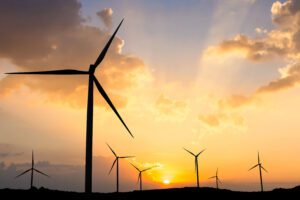
For the past year, I’ve been searching for the answer to one question: how can Alberta maintain its position as an energy leader in a world rapidly moving away from fossil fuels? When petroleum has driven the economy for fifty years, how can Alberta shift to renewable energy along with most of the rest of the globe?
I wish I could report that such a transition in Alberta is simply a matter of when, not if. But that’s not the case. There is a real risk that Alberta will miss the renewable energy train and instead be relegated to an energy and economic caboose.
If this happens, we will only have ourselves to blame.
Black gold and the backbone of the Alberta economy
Black gold (oil) only became a critical component of Alberta’s economy after Premier Peter Lougheed rewrote the provincial royalty regulations in 1973, which turned out to be a well-timed event just before the OPEC crisis sent shock waves through energy markets and netted Alberta billions in new wealth. The huge royalties lasted for about a decade, before oil prices – and Alberta’s revenue share of royalties – settled into a pattern of smaller booms and deeper busts.
But Alberta was hooked. It’s possible that what we’re experiencing today is the last oil boom, and a long, hard bust will follow.
The last oil boom and a long bust ahead
Alberta can’t afford to ignore today’s boom-bust cycle, because this one is different from all the rest. Unlike previous cycles, this boom is fueled exclusively by company profits, not jobs, not royalties, and the coming bust is the result of a systemic weakness in our provincial economy: our overdependence on fossil fuels, a non-renewable resource revenue for our core activities, like schools and hospitals.
There are dozens of elements to consider when framing an energy transition strategy, but in Alberta, they break down to two unique but interconnected paths:
- Pathway one: Alberta’s dependence on royalties for our core budget, such as health care, education, transportation and infrastructure.
- Pathway two: electrification of the grid, weaning us from greenhouse gas-polluting methane (natural gas).
Petrostate today, but what about tomorrow?
There will be an inevitable decline – and eventual end – to our reliance on carbon-based fuels for our transportation, heating, industry, agriculture, and commerce. It might be five years away. Maybe it’s ten years out. However, there is little doubt that it is coming to an end, and the impact this could have on Alberta is enormous.
Alberta is a petrostate, “a country [or state, or province] that heavily relies on the export of oil or natural gas.” Today, about a quarter of the revenue we collect as a province comes from oil and gas royalties, leases and other financial tools. That’s problem number one: in a transition to clean energy, how do we replace the $20-$30B in our budget that comes from oil and gas?
To address this challenge, we can’t just sell more crude oil. The world doesn’t want any more of our oil. While production levels continue to rise in Alberta, demand for various oil and gas products is levelling out and even starting to decline. According to the International Energy Agency (IEA), global demand for oil is falling, in part because of the trade war, and in part because alternatives like renewable energy are increasing quickly and at lower prices.
Changes needed in Alberta’s industrial model
Whether we like it or not, we’re going to have to talk about changing Alberta’s industrial model, from one based on an ever-expanding oil and gas industry, to one that relies on a much wider range of industries, including manufacturing, construction, renewable energy, agriculture and agrifood, and professional services. None of these sectors alone can make up the gross domestic product (GDP) that oil has represented (about twenty-five percent of Alberta’s GDP). However, Alberta’s other strong industries can make up for the weakness that the petroleum industry will soon display.
Can Albertans adopt a new story of ourselves?
Over the next few months, we’ll talk more about the Alberta energy transition. We’ll be asking questions like, without oil and gas, how will Alberta pay the bills? What about the 135,000 people who currently work in the petroleum business? Is it really cheaper to heat our homes and light our streets with renewable energy? If so, how do we do it? Maybe the most important question, however, is can Albertans adopt a story about who we are – what is our provincial identity – if it is not being an oil and gas province?
We hope you’ll come along for the discussion.
The post Energy Transition 101: Making the Case appeared first on Environmental Defence.
This post was originally published on Environmental Defence.





